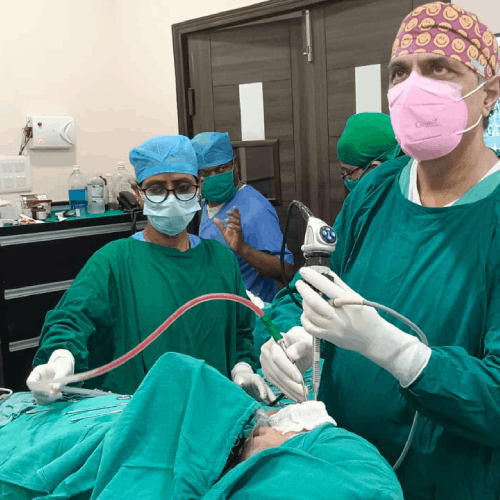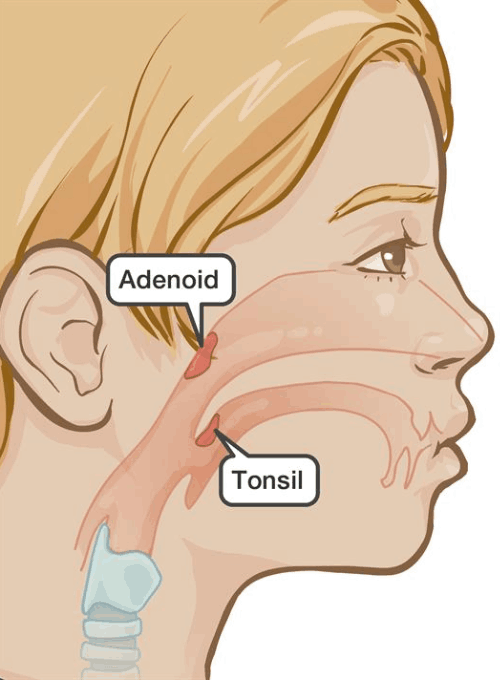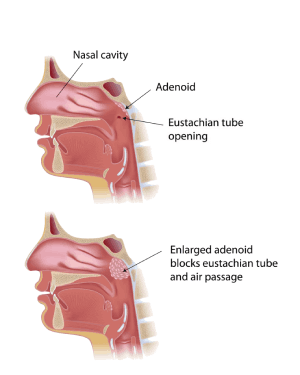Adenoidectomy – A Surgery for Adenoid Removal
Adenoidectomy is a surgery performed to remove enlarged Adenoid tissue (which is a mass of lymphoid aggregate behind the nose, in an area called the Nasopharynx).
Indications for Adenoid removal (Adenoidectomy)
- Enlarged adenoids causing nasal obstruction and leading to sleep disturbed breathing in children
- Enlarged Adenoids causing recurrent middle ear infection, pain in the ears, impaired hearing in children.
- As part of a combined procedure which includes Myringotomy with Grommet insertion (also called Tube insertion)
How is the Adenoidectomy Procedure Performed?
Classically Adenoidectomy is performed through an open mouth (there is no mark, cut or incision outside or on the skin anywhere – it is all done through the Nose and Throat).
The ENT surgeon will use a mouth gag and tongue depressor to open the mouth of the child. The soft palate is then retracted by soft tubes inserted through each nostril and brought out from the mouth. This opens up the Nasopharynx – the region behind the nose where the Adenoids reside. Either under direct vision or using angled Endoscopes the Adenoid tissue is removed bit by bit till none is left.
The entire procedure takes about half to one hour depending upon the method used.
After the surgery the child is nursed in a special position and kept in the Recovery Room till completely recovered from the effects of anaesthesia.

Adenoid Surgery with Tube Insertion


Adenoids are soft tissue behind the nose that helps your child fight infection. As a result, fluid can build up behind the eardrums. This can cause pain and hearing loss.
During ear tube insertion, your child’s healthcare provider places a tiny tube into the eardrum to let fluid leave the middle ear. It also lets air enter the middle ear through the eardrum. By the time these tubes come out, the body’s natural passageway from the middle ear to the back of the nose may be working better.
This procedure is very common in children. Your child may need an ear tube insertion if he or she:
- Has had fluid in the ears for 3 or more months
- Has had a long-running ear infection
- Gets ear infections often
- Has an abnormal shape to his or her ears or mouth
- Has had certain ear injuries
Methods of performing Adenoidectomy
- Regular Cold Steel Adenoid removal – using Adenoid curettes and cage.
- Coblation assisted – using a Coblation wand which goes under the adenoid tissue and removes it using heat supplied via a dedicated console.
- Microdebrider assisted – using special Microdebrider probes and using suction and cutting.
Complications of Adenoidectomy
Complications of Anaesthesia – though safe there may be some complications related to the use of Anaesthetic agents and General Anaesthesia – these are best discussed with the Anaesthetist before the surgery. They may include drug related side effects, sedation, requirement for prolonged intubation or more.
Complications of the surgery
- Bleeding – though there is minimal bleeding during an Adenoidectomy sometimes there may be excessive intra operative or post operative period. There may be bleeding 7-10 days after the procedure – this is known as secondary haemorrhage and is usually controlled with antibiotics.
- Infection – may happen in the post operative period though a routine prophylactic is prescribed for about 48 hours post surgery.
- Nasal Regurgitation- if excessive tissue is removed – this usually recovers spontaneously over a period of time.
- Change of Voice – because bulky tissue is removed the voice may change (usually becomes clearer) after the surgery. If the patient is a child artist as singer you must discuss this with the surgeon and speech therapist because the voice after the surgery may be different.

Adenoidectomy - Post Operative Care
- Regular nursing
- Proper nutrition – usually there is minimal dietary restriction after an Adenoidectomy – chilly/ spicy/ hard food is usually better avoided for about a week. Sour things may be avoided for a few days.
- Medication as advised and gargles as prescribed
- Routine post op visit with the surgeon including a review of the Histopathology report.
Modern Excellence in Adenoid Surgery: MedFirst ENT Centre’s Advantage
MediFirst ENT Centre stands out as the superior choice for Enlarged Adenoid Removal Surgery (Adenoidectomy) due to several compelling reasons:
Unparalleled Surgical Expertise: Our centre boasts the region’s most experienced surgeons, with a track record of over 10,000 successful surgeries, ensuring patients receive top-tier care and outcomes.
State-of-the-Art Facilities: As a dedicated nose, ear, and throat hospital, we provide cutting-edge, modern facilities equipped with advanced technology, guaranteeing the highest standards of medical care.
Compassionate and Proficient Staff: Our team comprises polite and highly experienced professionals dedicated to patient comfort and well-being, offering a supportive and reassuring environment throughout the surgical journey.
At MediFirst ENT Centre, we prioritize patient satisfaction, safety, and optimal results, making us the preferred destination for Enlarged Adenoid Removal Surgery.
MedFirst Advantage – Adenoidectomy with Insurance Policy & TPA support
MedFirst ENT Centre is dedicated to providing a seamless experience for patients seeking ENT-related medical care, including procedures like adenoidectomy. Their affiliations with major insurance companies ensure the efficient management of the financial aspects of treatments. Their adept Third Party Administrator (TPA) team, experienced in adenoidectomy claims, streamlines the health claim process for a stress-free experience. Whether patients require care under a Group Health Insurance Plan, Individual/Family Health Insurance Plan, or coverage for adenoidectomy, MedFirst ENT Centre’s extensive network and dedicated TPA team ensure smooth health insurance claims processing. This relieves patients of administrative burdens and allows them to focus on their health. Their commitment to ensuring insurance-related processes run seamlessly underscores their dedication to patient care and convenience.
Understanding how your health insurance policy and TPA can assist in covering adenoidectomy costs is vital when considering this surgical procedure to address breathing and related issues. Proactive measures, such as policy review and coordination with an experienced TPA, help ensure a confident and cost-effective adenoidectomy experience. This proactive approach allows patients to breathe easier, both physically and financially.
Adenoidectomy (Adenoids Removal Surgery) - FAQ
Adenoidectomy is typically associated with paediatric patients, as adenoids tend to be more prominent in children and are often a source of various health issues in this age group. However, it is not exclusive to children. In some cases, adults may also require adenoidectomy to alleviate symptoms such as chronic nasal congestion or sleep apnoea caused by enlarged adenoids. The decision to perform adenoidectomy in adults is based on individual health assessments.
Typically, Nasal blockage, mouth breathing, snoring and sleep disturbed breathing are cured by the surgery.
Frequent ear infections also settle down
Some form of Myofunctional therapy will have to be given to improve the nasal breathing post operatively.
The cost of adenoidectomy surgery can vary significantly depending on factors like location, the complexity of the procedure, and whether it’s performed in an outpatient or hospital setting Use of Coblation device significantly increases the cost since the wands used are single use disposable wands. In many cases, health insurance plans do cover adenoidectomy if it’s deemed medically necessary. Patients should check with their insurance provider to understand coverage specifics, including deductibles and co-pays, to determine their out-of-pocket expenses for the surgery.
Ideally Adenoidectomy is a day care procedure – the patient is admitted early in the morning and usually discharged the same day.
You are ready to be discharged as soon as the patient has recovered from the full effects of anaesthesia.
Follow up visit usually happens on day 5 after the surgery
And what precautions should be taken after the adenoidectomy surgery?
- Avoid eating very spicy or chilly food
- Avoid vigorous nose blowing
- Take medication as prescribed
- Avoid going outdoors or playing in dusty areas for a few days – till the tissue heals
- Inform the doctor immediately in case of bleeding from the nose or mouth.
Address
D 3/14, Ground Floor
Vasant Vihar
New Delhi 110 057
Mobile: +91 98711 50032
Hour of Operation
Monday To Saturday
Morning Timing
09:30 AM to 11:30 AM
Evening Timings
4:30 PM to 7:00 PM
Thursday Morning Clinic Is Closed
Thursday Evening
4:30 PM to 7:00 PM
Let's Get In Touch. Contact us.
Get Connected

Get In Touch
Subscribe For Health Updates

- © 2023 MedFirst ENT Centre
